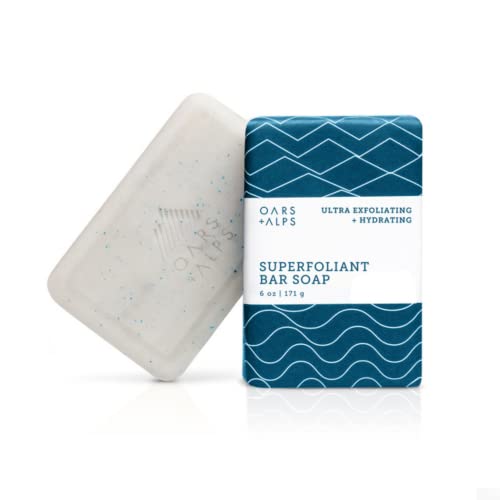
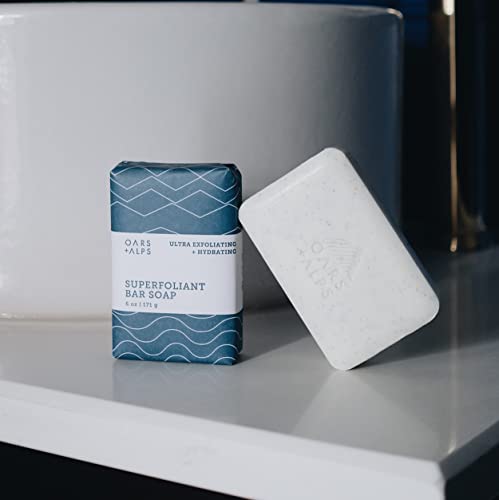
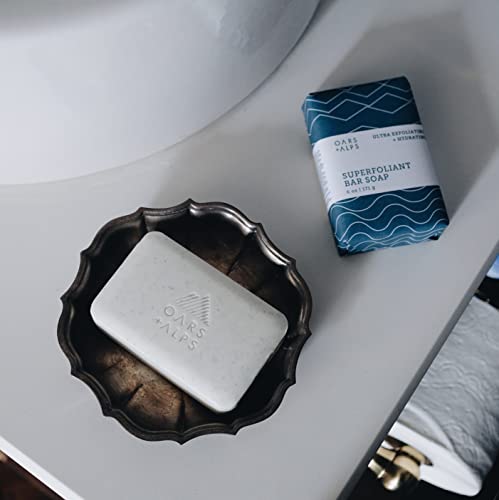
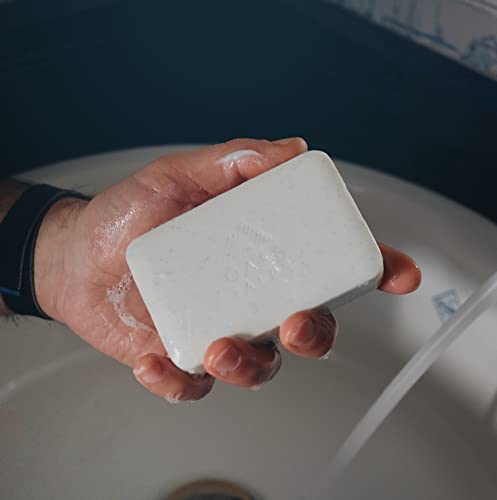
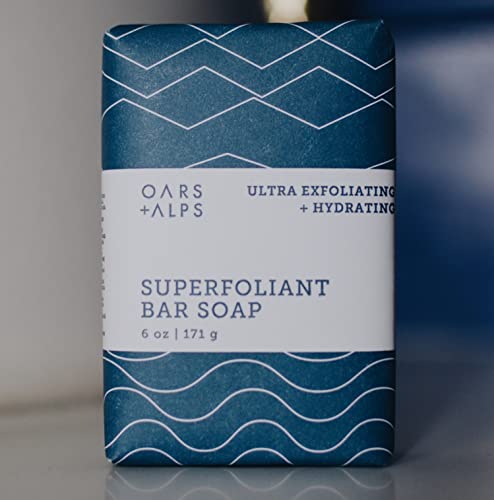
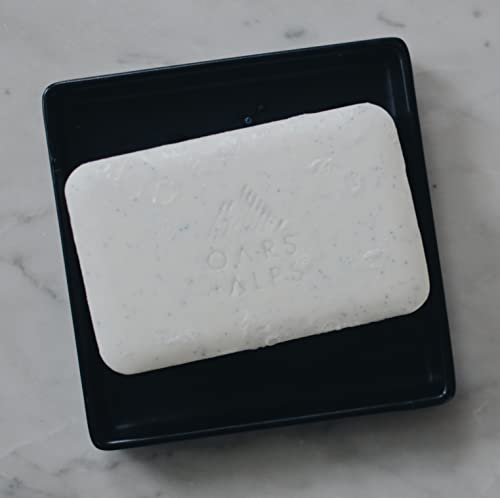
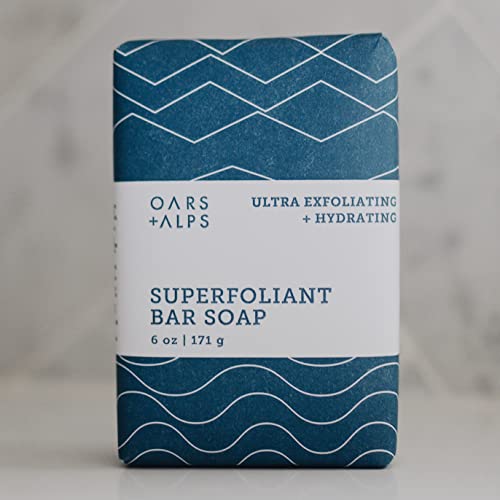
Oars + Alps Exfoliating Men's Bar Soap - Jojoba Beads, Hydrating Shea & Coconut Oils - 6 Oz


Fragrance
High RiskFragrance refers to a mixture of aromatic compounds used in products to provide scent. It is commonly listed as 'fragrance' or 'parfum' on product labels and can serve various functions, including enhancing user experience and masking undesirable odors.
Sustai Insights
Fragrance offers functional benefits by improving product appeal; however, it poses significant health risks, notably a high likelihood of causing allergies and allergic contact dermatitis. Environmental risks include potential pollution and endocrine disruption, though its overall carcinogenicity is low. Regulatory bodies have noted concerns regarding its use, leading to a high-risk classification. Safe usage practices should be observed, and alternatives such as natural essential oils are recommended for those sensitive to synthetic fragrances.
Tetrasodium Etidronate
High RiskTetrasodium etidronate is a diphosphonic acid used primarily as a chelating agent in various products. It functions to bind metal ions, thereby preventing the adverse effects of hardness in water and improving product stability. This ingredient is often found in personal care and household products.
Sustai Insights
Tetrasodium etidronate effectively acts as a chelating agent, enhancing product performance by improving stability and preventing metal ion interference. However, it is associated with high use restrictions, potential skin irritation, and is considered to have low risk for carcinogenicity and allergies. Regulatory agencies have advised caution, with its environmental profile indicating potential pollution risks. Overall, while it serves functional benefits, the high-risk assessment suggests careful consideration of its use in formulations, with safer alternatives recommended where possible.
Pumice
Medium RiskPumice is a volcanic rock that consists mainly of silica and is characterized by its porous structure. It is primarily used in cosmetic products as an abrasive agent, often found in exfoliating scrubs and foot care formulations to help remove dead skin cells.
Sustai Insights
Pumice provides effective physical exfoliation, enhancing skin texture and appearance. It is sustainably sourced from volcanic regions, and its natural composition supports biodegradability. However, concerns include potential skin irritation and enhanced absorption, with moderate usage restrictions in certain applications. Regulatory bodies have advised caution due to these factors. Overall, the ingredient is assessed as medium risk, warranting safe usage practices and consideration of gentler alternatives when available.
Titanium Dioxide
Medium RiskTitanium dioxide is an inorganic compound used primarily as a pigment due to its brightness and high refractive index. It is commonly found in products such as paints, coatings, plastics, and cosmetics, providing color and opacity.
Sustai Insights
Titanium dioxide serves effectively as a UV filter and colorant, enhancing product stability and performance. However, it has been classified as a moderate concern for potential carcinogenicity and carries low risks for allergies and reproductive toxicity. Environmental risks include its pollutant potential, though it is not known to bioaccumulate. Regulatory bodies have issued specific restrictions regarding its use, leading to an overall medium risk assessment. Safe usage practices should be observed, with consideration for alternatives such as zinc oxide for a more sustainable option.
Spirulina Maxima (Algae) Extract
Medium RiskSpirulina maxima extract is an extract of the blue-green algae Spirulina maxima, commonly used in dietary supplements and cosmetics for its nutritional properties and potential skin benefits. It is rich in proteins, vitamins, and antioxidants, contributing to its functional applications in various formulations.
Sustai Insights
Spirulina maxima extract offers functional benefits, including nutritional support and antioxidant properties, making it popular in health products. It is recognized for being sustainably sourced and biodegradable. Health risks are minimal, with low concerns for carcinogenicity, allergies, and reproductive toxicity; however, contamination concerns persist. Regulatory bodies do not impose significant restrictions, indicating moderate risk overall. Safe usage practices are recommended, and alternatives include other algae extracts or plant-based ingredients.
Sea Salt
Low RiskSea salt is a mixture of inorganic salts derived primarily from the evaporation of seawater. It consists mainly of sodium chloride, with minor amounts of other minerals. Sea salt is commonly used as a seasoning and preservative in food products and may also have applications in cosmetics and personal care items.
Sustai Insights
Sea salt serves as an effective flavor enhancer and preservative, contributing to the taste and shelf-life of food products. It is generally considered safe with low risk for health concerns such as cancer, allergies, and reproductive toxicity. Environmental impact is minimal, as it does not contribute significantly to pollution or bioaccumulation. Regulatory bodies, including the FDA, currently do not impose restrictions on its use. Overall, the risk level associated with sea salt is low, making it a widely accepted ingredient with no significant adverse effects reported.
Vegetarian Glycerin
Low RiskVegetarian glycerin, also known as glycerol, is a colorless, odorless, and viscous liquid derived from plant sources. It is primarily used as a humectant, solvent, and emollient in various personal care products, helping to retain moisture and improve texture.
Sustai Insights
Vegetarian glycerin offers functional benefits as an effective humectant, promoting hydration and skin smoothness. It is biodegradable and typically sustainably sourced. Health risks associated with glycerin are low, with no significant concerns for carcinogenicity, allergens, or reproductive toxicity. Environmental risks are minimal, and it is not subject to major regulatory warnings. Overall, the risk level for this ingredient is low, making it a safe choice in formulations. Safe usage practices include ensuring proper concentrations in products, and alternatives such as propylene glycol exist but may have differing properties.
Cocos Nucifera (Coconut) Oil
Low RiskCocos Nucifera (Coconut) Oil is derived from the kernels of the coconut palm. It is primarily used in cosmetic formulations for its emollient and moisturizing properties, making it suitable for skin and hair care products.
Sustai Insights
Coconut oil serves as an effective moisturizer and emollient, promoting skin hydration and softness. It is sustainably sourced and biodegradable. Health risks are minimal, with low concerns regarding carcinogenicity, allergens, and reproductive toxicity. Environmental impact is also low, as it does not contribute significantly to pollution or bioaccumulation. Regulatory bodies have not issued restrictions on its use. Overall, coconut oil presents a low risk for health and environmental concerns, making it a safe ingredient in cosmetic products.
Hamamelis Virginiana (Witch Hazel) Leaf Extract
Low RiskHamamelis virginiana (witch hazel) leaf extract is derived from the leaves of the witch hazel plant. It is commonly used in cosmetic formulations for its astringent properties, helping to tighten and tone the skin. This extract is often included in products designed for skin care, particularly for soothing minor skin irritations.
Sustai Insights
Hamamelis virginiana leaf extract offers functional benefits as an astringent, which can help reduce skin inflammation and improve skin appearance. It is generally regarded as safe with low risk of health concerns, including carcinogenicity and allergenic potential. Environmental impacts are minimal, and it is not bioaccumulative. Regulatory bodies impose few restrictions, reflecting its acceptance in cosmetic formulations. Safe usage practices should be followed, and alternatives like green tea extract may provide similar benefits with enhanced antioxidant properties. Overall, the risk level associated with this ingredient is low.
Sodium Cocoate
Low RiskSodium cocoate is the sodium salt of fatty acids derived from coconut oil. It is primarily used in cosmetic formulations as a surfactant and cleansing agent, effectively helping to emulsify oils and fats, contributing to the overall texture and performance of the product.
Sustai Insights
Sodium cocoate acts as an effective surfactant and cleansing agent, offering functional benefits in personal care products. It is biodegradable and derived from renewable sources, contributing to sustainability. Health risks are low, as it is not associated with carcinogenicity, significant allergenic potential, or reproductive toxicity. However, it may cause mild irritation to skin, eyes, or lungs. Regulatory bodies have not imposed significant restrictions, affirming its safety for use. Overall, it presents a low-risk profile, making it a suitable choice in formulations.
Water
Low RiskWater is a clear, colorless liquid essential for various biological processes. It serves as a solvent in formulations, facilitating the dissolution of other ingredients and enhancing product texture and application. Additionally, water plays a crucial role in hydration and is a key component in many cosmetic and personal care products.
Sustai Insights
Water is an effective solvent and hydrator, contributing to the texture and efficacy of formulations. It is biodegradable and generally regarded as safe, with low concerns regarding carcinogenicity, allergies, and reproductive toxicity. However, excessive water usage can lead to environmental concerns, particularly regarding resource depletion. Regulatory bodies do not impose restrictions on water use in cosmetics. Overall, the risks associated with water are low, making it a safe and essential ingredient.
Pentasodium Dtpa
Low RiskPentasodium DTPA is a chelating agent used in cosmetic formulations to bind metal ions, enhancing product stability and efficacy. It helps prevent the degradation of active ingredients by sequestering harmful metals, thereby extending shelf life and improving performance in various formulations.
Sustai Insights
Pentasodium DTPA offers functional benefits as an effective chelating agent, contributing to product stability and preventing metal ion interference. It has a low risk of health concerns, with low associations for carcinogenicity and allergies; however, there are moderate concerns regarding developmental and reproductive toxicity. Environmentally, it poses minimal risks, as it is not bioaccumulative. Regulatory bodies have not imposed significant restrictions. Overall, it is assessed as low risk, making it a relatively safe choice in cosmetic formulations. Alternatives could include other chelating agents like sodium phytate.
Helianthus Annuus (Sunflower) Seed
Low RiskHelianthus annuus (sunflower) seed is derived from the seeds of the sunflower plant and is commonly used in various cosmetic and personal care products. It serves primarily as an emollient and skin conditioning agent, providing moisture and enhancing the texture of formulations.
Sustai Insights
Helianthus annuus (sunflower) seed offers functional benefits, including skin conditioning and moisturizing properties, while being sustainably sourced and biodegradable. Health risks are minimal, with low concerns for carcinogenicity, allergies, and reproductive toxicity. Environmentally, it presents low risks of pollution or bioaccumulation. Regulatory assessments indicate no current restrictions. Overall, it is considered a low-risk ingredient, and safe usage practices should be maintained. Alternative ingredients may include other plant-based oils, but the sunflower seed oil remains a viable option.
Sodium Palmate
Low RiskSodium palmate is the sodium salt of fatty acids derived from palm oil, commonly used as a surfactant and emulsifier in cosmetic formulations. It helps to create lather and improve the texture of products, making it a popular ingredient in soaps and cleansers.
Sustai Insights
Sodium palmate offers functional benefits such as effective cleansing and emulsifying properties, contributing to product stability. It is considered low risk for health concerns, including carcinogenicity and allergenic potential, and has no significant environmental hazards. Regulatory bodies have not imposed restrictions on its use. Safe usage involves adhering to established concentrations, with no major alternatives highlighted. Overall, sodium palmate presents a low risk profile.
Fragrance
High RiskFragrance refers to a mixture of aromatic compounds used in products to provide scent. It is commonly listed as 'fragrance' or 'parfum' on product labels and can serve various functions, including enhancing user experience and masking undesirable odors.
Sustai Insights
Fragrance offers functional benefits by improving product appeal; however, it poses significant health risks, notably a high likelihood of causing allergies and allergic contact dermatitis. Environmental risks include potential pollution and endocrine disruption, though its overall carcinogenicity is low. Regulatory bodies have noted concerns regarding its use, leading to a high-risk classification. Safe usage practices should be observed, and alternatives such as natural essential oils are recommended for those sensitive to synthetic fragrances.
Sea Salt
Low RiskSea salt is a mixture of inorganic salts derived primarily from the evaporation of seawater. It consists mainly of sodium chloride, with minor amounts of other minerals. Sea salt is commonly used as a seasoning and preservative in food products and may also have applications in cosmetics and personal care items.
Sustai Insights
Sea salt serves as an effective flavor enhancer and preservative, contributing to the taste and shelf-life of food products. It is generally considered safe with low risk for health concerns such as cancer, allergies, and reproductive toxicity. Environmental impact is minimal, as it does not contribute significantly to pollution or bioaccumulation. Regulatory bodies, including the FDA, currently do not impose restrictions on its use. Overall, the risk level associated with sea salt is low, making it a widely accepted ingredient with no significant adverse effects reported.
Vegetarian Glycerin
Low RiskVegetarian glycerin, also known as glycerol, is a colorless, odorless, and viscous liquid derived from plant sources. It is primarily used as a humectant, solvent, and emollient in various personal care products, helping to retain moisture and improve texture.
Sustai Insights
Vegetarian glycerin offers functional benefits as an effective humectant, promoting hydration and skin smoothness. It is biodegradable and typically sustainably sourced. Health risks associated with glycerin are low, with no significant concerns for carcinogenicity, allergens, or reproductive toxicity. Environmental risks are minimal, and it is not subject to major regulatory warnings. Overall, the risk level for this ingredient is low, making it a safe choice in formulations. Safe usage practices include ensuring proper concentrations in products, and alternatives such as propylene glycol exist but may have differing properties.
Cocos Nucifera (Coconut) Oil
Low RiskCocos Nucifera (Coconut) Oil is derived from the kernels of the coconut palm. It is primarily used in cosmetic formulations for its emollient and moisturizing properties, making it suitable for skin and hair care products.
Sustai Insights
Coconut oil serves as an effective moisturizer and emollient, promoting skin hydration and softness. It is sustainably sourced and biodegradable. Health risks are minimal, with low concerns regarding carcinogenicity, allergens, and reproductive toxicity. Environmental impact is also low, as it does not contribute significantly to pollution or bioaccumulation. Regulatory bodies have not issued restrictions on its use. Overall, coconut oil presents a low risk for health and environmental concerns, making it a safe ingredient in cosmetic products.
Pumice
Medium RiskPumice is a volcanic rock that consists mainly of silica and is characterized by its porous structure. It is primarily used in cosmetic products as an abrasive agent, often found in exfoliating scrubs and foot care formulations to help remove dead skin cells.
Sustai Insights
Pumice provides effective physical exfoliation, enhancing skin texture and appearance. It is sustainably sourced from volcanic regions, and its natural composition supports biodegradability. However, concerns include potential skin irritation and enhanced absorption, with moderate usage restrictions in certain applications. Regulatory bodies have advised caution due to these factors. Overall, the ingredient is assessed as medium risk, warranting safe usage practices and consideration of gentler alternatives when available.
Hamamelis Virginiana (Witch Hazel) Leaf Extract
Low RiskHamamelis virginiana (witch hazel) leaf extract is derived from the leaves of the witch hazel plant. It is commonly used in cosmetic formulations for its astringent properties, helping to tighten and tone the skin. This extract is often included in products designed for skin care, particularly for soothing minor skin irritations.
Sustai Insights
Hamamelis virginiana leaf extract offers functional benefits as an astringent, which can help reduce skin inflammation and improve skin appearance. It is generally regarded as safe with low risk of health concerns, including carcinogenicity and allergenic potential. Environmental impacts are minimal, and it is not bioaccumulative. Regulatory bodies impose few restrictions, reflecting its acceptance in cosmetic formulations. Safe usage practices should be followed, and alternatives like green tea extract may provide similar benefits with enhanced antioxidant properties. Overall, the risk level associated with this ingredient is low.
Sodium Cocoate
Low RiskSodium cocoate is the sodium salt of fatty acids derived from coconut oil. It is primarily used in cosmetic formulations as a surfactant and cleansing agent, effectively helping to emulsify oils and fats, contributing to the overall texture and performance of the product.
Sustai Insights
Sodium cocoate acts as an effective surfactant and cleansing agent, offering functional benefits in personal care products. It is biodegradable and derived from renewable sources, contributing to sustainability. Health risks are low, as it is not associated with carcinogenicity, significant allergenic potential, or reproductive toxicity. However, it may cause mild irritation to skin, eyes, or lungs. Regulatory bodies have not imposed significant restrictions, affirming its safety for use. Overall, it presents a low-risk profile, making it a suitable choice in formulations.
Water
Low RiskWater is a clear, colorless liquid essential for various biological processes. It serves as a solvent in formulations, facilitating the dissolution of other ingredients and enhancing product texture and application. Additionally, water plays a crucial role in hydration and is a key component in many cosmetic and personal care products.
Sustai Insights
Water is an effective solvent and hydrator, contributing to the texture and efficacy of formulations. It is biodegradable and generally regarded as safe, with low concerns regarding carcinogenicity, allergies, and reproductive toxicity. However, excessive water usage can lead to environmental concerns, particularly regarding resource depletion. Regulatory bodies do not impose restrictions on water use in cosmetics. Overall, the risks associated with water are low, making it a safe and essential ingredient.
Tetrasodium Etidronate
High RiskTetrasodium etidronate is a diphosphonic acid used primarily as a chelating agent in various products. It functions to bind metal ions, thereby preventing the adverse effects of hardness in water and improving product stability. This ingredient is often found in personal care and household products.
Sustai Insights
Tetrasodium etidronate effectively acts as a chelating agent, enhancing product performance by improving stability and preventing metal ion interference. However, it is associated with high use restrictions, potential skin irritation, and is considered to have low risk for carcinogenicity and allergies. Regulatory agencies have advised caution, with its environmental profile indicating potential pollution risks. Overall, while it serves functional benefits, the high-risk assessment suggests careful consideration of its use in formulations, with safer alternatives recommended where possible.
Titanium Dioxide
Medium RiskTitanium dioxide is an inorganic compound used primarily as a pigment due to its brightness and high refractive index. It is commonly found in products such as paints, coatings, plastics, and cosmetics, providing color and opacity.
Sustai Insights
Titanium dioxide serves effectively as a UV filter and colorant, enhancing product stability and performance. However, it has been classified as a moderate concern for potential carcinogenicity and carries low risks for allergies and reproductive toxicity. Environmental risks include its pollutant potential, though it is not known to bioaccumulate. Regulatory bodies have issued specific restrictions regarding its use, leading to an overall medium risk assessment. Safe usage practices should be observed, with consideration for alternatives such as zinc oxide for a more sustainable option.
Pentasodium Dtpa
Low RiskPentasodium DTPA is a chelating agent used in cosmetic formulations to bind metal ions, enhancing product stability and efficacy. It helps prevent the degradation of active ingredients by sequestering harmful metals, thereby extending shelf life and improving performance in various formulations.
Sustai Insights
Pentasodium DTPA offers functional benefits as an effective chelating agent, contributing to product stability and preventing metal ion interference. It has a low risk of health concerns, with low associations for carcinogenicity and allergies; however, there are moderate concerns regarding developmental and reproductive toxicity. Environmentally, it poses minimal risks, as it is not bioaccumulative. Regulatory bodies have not imposed significant restrictions. Overall, it is assessed as low risk, making it a relatively safe choice in cosmetic formulations. Alternatives could include other chelating agents like sodium phytate.
Spirulina Maxima (Algae) Extract
Medium RiskSpirulina maxima extract is an extract of the blue-green algae Spirulina maxima, commonly used in dietary supplements and cosmetics for its nutritional properties and potential skin benefits. It is rich in proteins, vitamins, and antioxidants, contributing to its functional applications in various formulations.
Sustai Insights
Spirulina maxima extract offers functional benefits, including nutritional support and antioxidant properties, making it popular in health products. It is recognized for being sustainably sourced and biodegradable. Health risks are minimal, with low concerns for carcinogenicity, allergies, and reproductive toxicity; however, contamination concerns persist. Regulatory bodies do not impose significant restrictions, indicating moderate risk overall. Safe usage practices are recommended, and alternatives include other algae extracts or plant-based ingredients.
Helianthus Annuus (Sunflower) Seed
Low RiskHelianthus annuus (sunflower) seed is derived from the seeds of the sunflower plant and is commonly used in various cosmetic and personal care products. It serves primarily as an emollient and skin conditioning agent, providing moisture and enhancing the texture of formulations.
Sustai Insights
Helianthus annuus (sunflower) seed offers functional benefits, including skin conditioning and moisturizing properties, while being sustainably sourced and biodegradable. Health risks are minimal, with low concerns for carcinogenicity, allergies, and reproductive toxicity. Environmentally, it presents low risks of pollution or bioaccumulation. Regulatory assessments indicate no current restrictions. Overall, it is considered a low-risk ingredient, and safe usage practices should be maintained. Alternative ingredients may include other plant-based oils, but the sunflower seed oil remains a viable option.
Sodium Palmate
Low RiskSodium palmate is the sodium salt of fatty acids derived from palm oil, commonly used as a surfactant and emulsifier in cosmetic formulations. It helps to create lather and improve the texture of products, making it a popular ingredient in soaps and cleansers.
Sustai Insights
Sodium palmate offers functional benefits such as effective cleansing and emulsifying properties, contributing to product stability. It is considered low risk for health concerns, including carcinogenicity and allergenic potential, and has no significant environmental hazards. Regulatory bodies have not imposed restrictions on its use. Safe usage involves adhering to established concentrations, with no major alternatives highlighted. Overall, sodium palmate presents a low risk profile.
Experience the revitalizing power of Oars + Alps Superfoliant Exfoliating Men's Bar Soap. This dermatologist-tested, travel-sized solution is crafted with clean ingredients to deliver a refreshing cleanse while respecting your health and the environment.
- Natural Exfoliation: Jojoba beads gently remove dead skin cells, revealing softer, healthier skin with every wash.
- Balanced Skin: Spirulina helps maintain pH levels, ensuring your skin feels nourished and balanced after each use.
- Intense Hydration: Enriched with shea butter, coconut oil, and sunflower seed oil, this soap provides deep moisture for dry skin.
- Oil Control: Witch hazel acts as a natural astringent, effectively reducing excess oil for a fresh, matte finish.
- Sustainable Choice: Committed to sustainability, Oars + Alps prioritizes eco-friendly practices without compromising on quality.
Ideal for regular use, this exfoliating soap transforms your cleansing routine into a refreshing ritual, perfect for maintaining smooth and healthy skin.
Subscribe & Save with Sustai
- Best Price Guarantee: Always enjoy the lowest prices on sustainable home essentials.
- No Surprises: We’ll notify you before shipping. No hidden fees, ever.
- You’re in Charge: Change, pause, or cancel your subscription anytime with ease.
- Eco-Friendly Deliveries: Our grouped shipments mean less packaging and lower emissions.
Join us on a sustainable journey. Special offers for a limited time! Prices and promotions may change.
Recommended Products
Experience the revitalizing power of Oars + Alps Superfoliant Exfoliating Men's Bar Soap. This dermatologist-tested, travel-sized solution is crafted with clean ingredients to deliver a refreshing cleanse while respecting your health and the environment.
- Natural Exfoliation: Jojoba beads gently remove dead skin cells, revealing softer, healthier skin with every wash.
- Balanced Skin: Spirulina helps maintain pH levels, ensuring your skin feels nourished and balanced after each use.
- Intense Hydration: Enriched with shea butter, coconut oil, and sunflower seed oil, this soap provides deep moisture for dry skin.
- Oil Control: Witch hazel acts as a natural astringent, effectively reducing excess oil for a fresh, matte finish.
- Sustainable Choice: Committed to sustainability, Oars + Alps prioritizes eco-friendly practices without compromising on quality.
Ideal for regular use, this exfoliating soap transforms your cleansing routine into a refreshing ritual, perfect for maintaining smooth and healthy skin.

You can have at most 2 Sustainable Steals products in your cart
Customer Reviews
Customers’ View
Customers appreciate the effectiveness of the Exfoliating Bar Soap, noting its ability to cleanse and exfoliate the skin while leaving it feeling refreshed throughout the day. Key benefits highlighted include its powerful exfoliation with jojoba beads, which effectively removes dead skin, and the moisturizing properties of shea butter and coconut oil that provide intense hydration. Many users mention that it feels great on their skin, with one customer stating it's the best exfoliating bar they have ever used. Additionally, customers value the eco-friendly ingredients, supporting their environmentally conscious choices. Overall, this product resonates with users seeking both effective skincare and sustainable options.
AI-generated from the text of customer reviewsThis product has no reviews yet.




